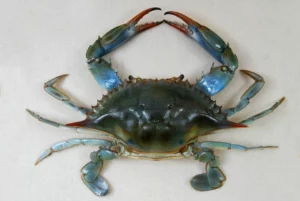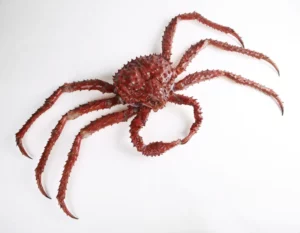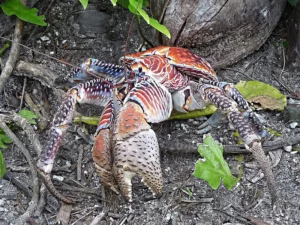Crabs come in more than 850 distinct species and thousands of various varieties. Major types of crab are listed below.
- Blue crab
- Snow Crab (Rock Crabs)
- King crab
- Japanese spider crab
- Brown crab
- Fiddler crab
- Coconut crab
- Mangrove Crab
- Hermit crab
- Ghost crab
Blue crab
Blue crabs that swim can get as wide as 9″ (23 cm) (excluding the length of the legs). This well-known crab type can be recognized by its body form in addition to the color of its blue shell (carapace). A Blue crab’s body side protrudes to a point rather than having a circular carapace.

Snow Crab (Rock Crabs)
Snow crabs (Chionoecetes opilio), an Alaskan crab variety are also known as rock crabs. Snow crabs are found in the chilly waters of Japan, Siberia, Alaska, and Greenland. Additionally, the North Atlantic Ocean and the frigid waters surrounding Alaska are home to this type of crab.
King Crab
Due to their big size, king crabs are among the most popular crabs. The Red King crab ranks among the largest in the world when it comes to huge crabs. These enormous crustaceans can have body up to 11″ (28 cm) wide and weigh up to 28 lbs (nearly 13 kg).

Japanese spider crab
A species of big crab with long legs is called Japanese Spider. It has a broad body that can reach a width of up to 16″ (40 cm). The massive cold-water crab has a maximum weight of 42 lbs (19 kg)
Brown Crab
A reddish-brown crab with reddish legs and claws is called the Brown crab (Cancer Pagurus), and it is edible. The black tips on this marine crab’s claws resemble those of the Florida Stone crab. One of the most well-liked crab species in the UK is the brown crab.
Fiddler crab
Fiddler crab males can be identified by their enormous claws, which they wave noisily in the air to attract females when mating. The distinctively big claw is absent in female fiddlers. Fiddlers frequently travel in groups. Numerous fiddler crabs are a sign of healthy marsh. They are considered an “indicator species” because they are sensitive to pollution.
Coconut crab
A coconut crab is a form of edible land crab (Birgus latro). In the Indian and Pacific oceans, coconut crabs live on islands. The term “coconut crab” refers to an animal’s propensity to scale palm trees to harvest coconuts, which they then crack open on the ground. They will steal anything delicious they can find, hence their other names are “robber crabs” or “palm thieves.”

Mangrove Crab
Mangrove crabs inhabit steppes or islands with plants that are extremely saltwater resistant. These crabs can be identified by their relatively slender, downward-sloping, oval cephalothorax that may be grey or bluish grey in colour with orange edges. Its claws are dark, and the ventral area is brown.
Hermit crab
Although most species of hermit crabs dwell in water, some can be found in the sand on the shores of beaches. When on land, they like to dwell inconspicuously behind the rocks where they may approach water to keep their gills moist so they can survive and breed. Hermit crabs cover their delicate bodies, which, in contrast to other crabs, do not harden, with the shells of snails or other mollusks.
Ghost crab
Ghost crabs are distinguished by having one claw that is bigger than the other. This characteristic is not as obvious as it is in male fiddler crabs. These crabs are part of the family ocypodidae, which also includes the taxon known as the fiddler crabs, and its subfamily ocypodinae, which has 22 species in two genera (Ucinae).
More examples of crabs
Many of the crustaceans that are referred to as crabs and “real crabs” differ from one another. Other varieties of real crab are listed below:
- Pygmy rock crab (Glebocarcinus oregonensis)
- Swamp crab (Pachygrapsus transversus)
- Chinese mitten crab (Eriocheir sinensis)
- Marbled rock crab (Pachygrapsus marmoratus)
- Grained crab (Neohelice granulata)
- Mouthless crab (Cardisoma crassum)
- Chilean king crab (Lithodes santolla)
- Florida stone crab (Menippe mercenaria)
- Black land crab (Gecarcinus ruricola)
- Moon crab (Gecarcinus lateralis)
Conclusion
From this article, it can be concluded that, crabs are a significant component of the marine ecosystem as they act as decomposers as well as contribute to the sanitization of the ocean floor by gathering decaying plant and animal materials.
Also Read:
- Types of rna splicing
- Obligate parasites examples
- Do bacteria form endospores
- Animal cell mitochondria functions
- Photosynthesis reaction
- Isomerase enzyme example
- Aquatic biome examples
- Lobster characteristics
- Is chromosome a chromatin
- Do proteins have phosphorus and sulfur

Hello, I am Bhairavi Rathod, I have completed my Master’s in Biotechnology and qualified ICAR NET 2021 in Agricultural Biotechnology. My area of specialization is Integrated Biotechnology. I have the experience to teach and write very complex things in a simple way for learners.